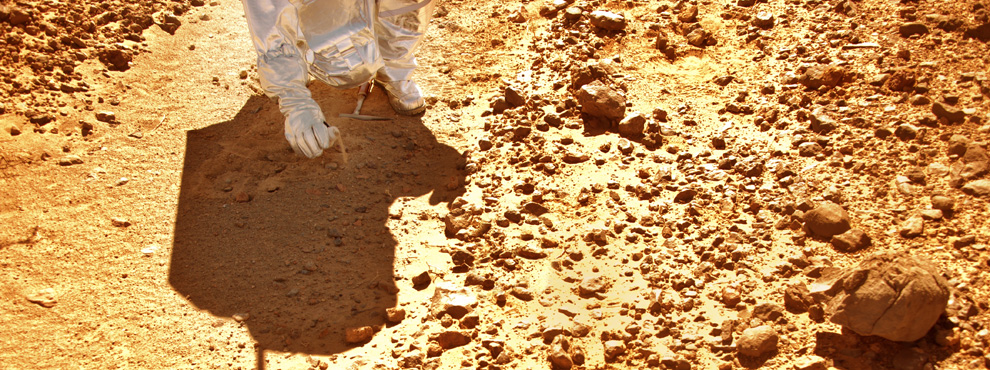
Analog Planetary Research
Paving the way for future human missions to the Moon and Mars
The Vienna Statement on Analog Planetary Research (VSAPR)
Analog Planetary Research (APR) is the development of equipment, methodologies and strategies for future human and robotic planetary exploration. It involves scientific, engineering, operational disciplines as well as human-factors to be tested in representative simulation environments to maximize the missions scientific return, optimize operational safety and catalyze technology transfer.APR has been around since the beginning of the space age. In the early years, it has been used by NASA to prepare astronauts for the Apollo missions (1) or to test the conditions of Skylab, the US’ first space station. (2) Since then, APR activities have immensely proliferated and are now being carried out by both government agencies (such as NASA or ESA) and non-governmental entities (such as research institutions, industry and citizen-science organizations). Throughout the years, APR has now emerged into a scientific and engineering discipline as a key enabling asset for future missions of exploration beyond Earth orbit.

A sample of analog missions. Top left: NASA Extreme Environment Mission Operations (NEEMO) Crew 16, including ESA astronaut Tim Peake (Credit: NASA); Top right: Hawai’i Space Exploration Analog and Simulation (HI-SEAS) habitat, jointly operated by NASA and the University of Hawai’i at Manoa (Credit: HI-SEAS); Bottom left: Crew in the Plant Cultivation Chamber of China’s Lunar Palace 1 (Credit: english.people.cn); Bottom right: Crew of Mars 500, a cooperative project between ESA and the Russian Institute for Biomedical Problems (Credit: ESA)
At the same time, there is a renewed interest amongst space agencies around the world to extend human spaceflight beyond low-earth orbit. NASA has embarked on its “Journey to Mars”. (3) ESA has begun to push the idea of a “Moon village”. (4) Chinese government officials have recently, for the first time ever, confirmed their plans for a crewed lunar mission before 2036. (5) And Russia wants to launch human missions to the moon from its new Vostochnoy space port by 2029. (6) These plans are bold and might suffer delays or cancellation due to budgetary pressures or shifts in policy priorities. But they show that the most important space agencies in the world all prepare for a time after the International Space Station and that their focus lies on returning humans to the Moon or to Mars.
For these reasons, the Austrian Space Forum (OeWF) as a secretary organization and researchers across the globe have now outlined the state, articulated benefits and stated goals of APR in order to communicate them within the scientific community, policy makers and the general public. After careful discussions, we developed the Vienna Statement on Analog Planetary Research (VSAPR).
The VSAPR is a single-paged declaration consisting of three parts:
The following individuals have signed the VSAPR by now:
- Kim Binsted, HI-SEAS research team, University of Hawaii at Manoa, United States
- Pablo De Leon, Department of Space Studies, University of North Dakota, United States
- Jean Pierre Paul De Vera, DLR Institute of Planetary Research, Germany
- Stefano Debei, University of Padova, Centre for Studies and Activities for Space (CISAS) “G. Colombo”, Italy
- Ludovic Ferriere, Natural History Museum Vienna, Austria
- Kai Gehreth, Mars Society Germany, Germany
- Cayetano Santana Gil, Mars Society Spain, Spain
- Felipe Gómez, Astrobiology Center (CAB), National Institute for Aerospace Technology (INTA), Spain
- Gernot Grömer, Austrian Space Forum, Austria
- Akos Kereszturi, Hungarian Academy of Sciences, Astrophysical and Geochemical Laboratory, Hungary
- Ryan L. Kobrick, Embry-Riddle Aeronautical University, United States
- Jesús Martínez-Frías, Spanish Planetology and Astrobiology Network, Spain
- Mihail Mateev, Mars Society Bulgaria, Bulgaria
- Michaela Musilová, Slovak Organisation for Space Activities, Slovakia
- Haritina Mogosanu, KiwiSpace Foundation, New Zealand
- Gordon Osinski, Centre for Planetary Science and Exploration, Canada
- Tibor Pacher, Puli Space Technologies, Hungary
- Ewan Reid, Mission Control Space Services Inc., Canada
- Jean-Marc Salotti, Bordeaux Institut National Polytechnique, France
- Brian Shiro, HI-SEAS research team, University of Hawaii at Manoa, United States
- James Skinner, US Geological Survey, United States
- Ulrich Walter, Technical University of Munich, Germany
- Peter Weiss, COMEX, France
If you are an established researcher with a proven record in analog planetary research:
- Consider becoming a signatory to the VSAPR.
If you are a student or a professional whose work is related to analog planetary research:
- Share the VSAPR through your communication channels, especially with your professional network.
- Refer to the VSAPR in your publications, grant proposals and professional communication.
If you are a policy maker or work in a funding agency:
- Consider the growing consensus about the value and importance of APR to human spaceflight during future discussions on funding priorities.
If you are an interested citizen:
- Share the VSAPR with people who might be interested.
- Follow APR activities around the world and learn more about this exciting field of research.
1) Mahoney, E. (2009): Past and Present: Field Testing For the Moon. July 2009. Online at: https://www.nasa.gov/exploration/analogs/then-and-now.html (last accessed: 09.05.2016)
2) Johnson, R.S. (1973): Skylab Medical Experiments Altitude Test (SMEAT). NASA Technical Report. October 1973.
3) NASA (2015): NASA releases plan outlining next steps in the journey to Mars. October 2015. Online at: https://www.nasa.gov/press-release/nasa-releases-plan-outlining-next-steps-in-the-journey-to-mars (last accessed: 09.05.2016)
4) ESA (2016): Moon village: humans and robots together on the Moon. March 2016. Online at: https://www.esa.int/About_Us/DG_s_news_and_views/Moon_Village_humans_and_robots_together_on_the_Moon (last accessed: 09.05.2016)
5) Martina, M. (2016): China aims for manned moon landing by 2036. Reuters. April 2016. Online at: https://www.reuters.com/article/us-china-space-moon-idUSKCN0XQ0JT (last accessed: 09.05.2016)
6) Russia Today (2015): Men on the Moon: Russia hopes to launch manned lunar mission in 2029. October 2015. Online at: https://www.rt.com/news/319840-russia-space-moon-landing/ (last accessed: 09.05.2016)
Dieser Artikel ist auch verfügbar auf: German
